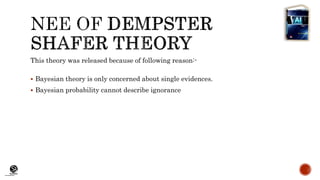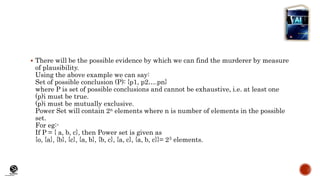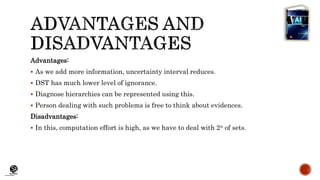Dempster shafer theory
- 1. Dr. C.V. Suresh Babu
- 2. (CentreforKnowledgeTransfer) institute Dempster Shafer Theory was given by Arthure P.Dempster in 1967 and his student Glenn Shafer in 1976. Arthure P.Dempster Glenn Shafer
- 3. (CentreforKnowledgeTransfer) institute This theory was released because of following reason:- Bayesian theory is only concerned about single evidences. Bayesian probability cannot describe ignorance
- 4. (CentreforKnowledgeTransfer) institute DST is an evidence theory, it combines all possible outcomes of the problem. Hence it is used to solve problems where there may be a chance that a different evidence will lead to some different result. The uncertainity in this model is given by:- 1. Consider all possible outcomes. 2. Belief will lead to believe in some possibility by bringing out some evidence.(What is this supposed to mean?) 3. Plausibility will make evidence compatible with possible outcomes.
- 5. (CentreforKnowledgeTransfer) institute Problem Let us consider a room where four people are present, A, B, C and D. Suddenly the lights go out and when the lights come back, B has been stabbed in the back by a knife, leading to his death. No one came into the room and no one left the room. We know that B has not committed suicide. Now we have to find out who the murderer is. Solution To solve these there are the following possibilities: Either {A} or {C} or {D} has killed him. Either {A, C} or {C, D} or {A, C} have killed him. Or the three of them have killed him i.e; {A, C, D} None of them have killed him {o} (let’s say).
- 6. (CentreforKnowledgeTransfer) institute There will be the possible evidence by which we can find the murderer by measure of plausibility. Using the above example we can say: Set of possible conclusion (P): {p1, p2….pn} where P is set of possible conclusions and cannot be exhaustive, i.e. at least one (p)i must be true. (p)i must be mutually exclusive. Power Set will contain 2n elements where n is number of elements in the possible set. For eg:- If P = { a, b, c}, then Power set is given as {o, {a}, {b}, {c}, {a, b}, {b, c}, {a, c}, {a, b, c}}= 23 elements.
- 7. (CentreforKnowledgeTransfer) institute Mass function m(K): It is an interpretation of m({K or B}) i.e; it means there is evidence for {K or B} which cannot be divided among more specific beliefs for K and B. Belief in K: The belief in element K of Power Set is the sum of masses of element which are subsets of K. This can be explained through an example Lets say K = {a, b, c} Bel(K) = m(a) + m(b) + m(c) + m(a, b) + m(a, c) + m(b, c) + m(a, b, c) Plausibility in K: It is the sum of masses of set that intersects with K. i.e; Pl(K) = m(a) + m(b) + m(c) + m(a, b) + m(b, c) + m(a, c) + m(a, b, c)
- 8. (CentreforKnowledgeTransfer) institute It will ignorance part such that probability of all events aggregate to 1.(What is this supposed to mean?) Ignorance is reduced in this theory by adding more and more evidences. Combination rule is used to combine various types of possibilities.
- 9. (CentreforKnowledgeTransfer) institute Advantages: As we add more information, uncertainty interval reduces. DST has much lower level of ignorance. Diagnose hierarchies can be represented using this. Person dealing with such problems is free to think about evidences. Disadvantages: In this, computation effort is high, as we have to deal with 2n of sets.








